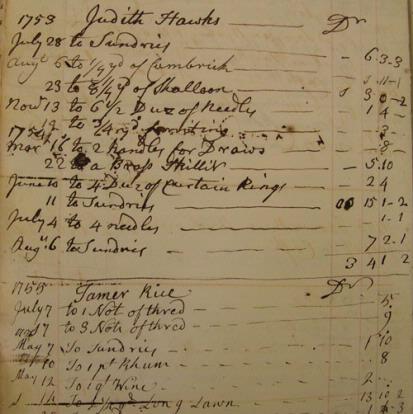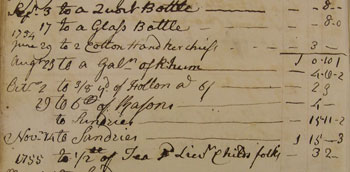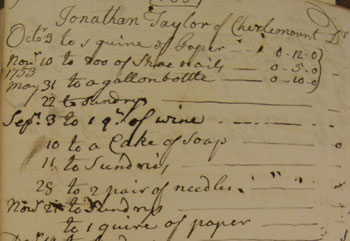Within the extensive collections of the Pocumtuck Valley Memorial Association Library at Deerfield is a treasure trove of documentary evidence regarding the history of Western Massachusetts. Among the thousands of books, correspondences, diaries, and so forth are a series of ledgers that were kept by one Deerfield shopkeeper and tavern-owner: Elijah Williams. Williams was from a prominent local family that was involved in all aspects of the area’s political, social, military, and economic life. During the majority of the eighteenth century, Elijah was directly involved in the majority of exchange that took place in the community, selling and buying everything from thimbles to cattle, and almost everything in-between.
To aid Williams and his employees in this traffic were a series of more than 20 day books and account books. Every transaction that took place on a given day was carefully entered into the day book with mention of the purchaser or creditor, the item, and the cost. Periodically, this information would then be copied into an account book in the section devoted to that specific individual in order to keep track of what they owed, or what was owed to them at any given time. As the great majority of business was done on the credit system, these detailed books were necessary in order to maintain the long lists and often-hefty balances of the customers. The usefulness of these books to modern researchers is readily apparent. Today we can get a first-hand view of the types of items and services that were available, the prices realized, who was making what purchases, when customers were in Deerfield, and much more. Another significant type of evidence revealed by these works is information about those customers that were not always well-represented in the rest of the documentary record.

These account books reveal the buying habits of the poor, women, children, and enslaved and free peoples of African descent that resided in the community but they did not always leave the written or material record of the more economically and socially-dominant populations.
Currently, a project is underway to transcribe and digitize this tremendous collection of eighteenth-century data. Eventually, this information will be placed on an internet-accessible, searchable catalogue that will allow researchers of all kinds to access the buying-habits of their studied individuals or ancestors and see every transaction that a given subject made from the 1740s to the 1770s. Additionally, one will be able to instantly access the tens of thousands of transactions for particular items or types of items to document the prices realized, range of styles, and types of purchasers. The possibilities are exciting and seemingly endless.
Let us briefly look at some of these transactions and the important insights they offer as they relate to the mid-eighteenth-century residents of the town of Charlemont. The residents of that satellite community of Deerfield were almost solely reliant on their parent community for the majority of goods and services they required and the books of Elijah Williams reflect the weekly or monthly arrival of these settlers for supplies.
One interesting way these ledgers can be used is to gain a better understanding of how individuals were not just spending, but generating income. By searching through the records and recording the credits to the various Charlemont accounts, one can see that Samuel Rice (from the family who were the first permanent Anglo-European residents of the settlement) was harvesting animal furs in February of 1753, including 5 red foxes, 1 grey, 1 raccoon, and 1 fisher cat. In the winter of 1755 he and his younger brother Artemis were back with martin pelts.

Not only do we learn of the economic importance of trapping to the residents of the frontier but we see that it was taking place in the winter months when the other tasks around the farms were minimal and the animals had their thicker winter coats. Additional information about the ecology of the area is also revealed. Despite the trapping or hunting activities, the primary economic livelihood of the Charlemont families was agriculture and animal husbandry. In November of 1753, Othniel Taylor sold 164 pounds of beef to Williams and his brother Jonathan Taylor made 9£, 6 shillings, and 8pence for “a yoke of oxen”. Meanwhile, the younger men from these families—those who had not yet established households of their own—often hired themselves out to others in the town and at Deerfield. In July of 1755, Aaron rice was paid for “1 day hoeing” and another “day reaping”. 
The most straightforward data that can be gathered from these accounts regards the types of items that were purchased. Textiles and associated items for clothing manufacture often dominate the item inventories. A myriad of available fabric types and color combinations was available with listings such as “spotted lawn”, “shalloon”, “ribbon”, “lace”, “kersey”, “cambrick”, “callimanco” “muslin”, “chince”, and on and on, not to mention the thimbles, scissors, and thousands of pin transactions also found  throughout the accounts.
throughout the accounts.
Books and other reading and writing materials were also prevalent in these communities, with references to Jonathan Taylor’s 1752 purchase of a “quire of paper” or his brother Othniel’s “brass inkpot” bought in 1755.  Othniel also purchased an almanac in 1752, Samuel Rice a 2 shilling, 1 pence “testament” the following year along with “a spelling book” likely designed for his young sons’ education. Titus King, a Northampton militiaman living with the Rices, bought “12 long pipes” in the fall of 1754 and 1 lb., 5 oz. of tobacco the following spring. That early summer he was taken captive in Charlemont by a small war party of Native Americans and would later recall that “they asked me for tobacco I gave them out a good twist they Cut Each of them a pipe full”.[i] This was very likely the same leaf he had purchased that April from Elijah Williams.
Othniel also purchased an almanac in 1752, Samuel Rice a 2 shilling, 1 pence “testament” the following year along with “a spelling book” likely designed for his young sons’ education. Titus King, a Northampton militiaman living with the Rices, bought “12 long pipes” in the fall of 1754 and 1 lb., 5 oz. of tobacco the following spring. That early summer he was taken captive in Charlemont by a small war party of Native Americans and would later recall that “they asked me for tobacco I gave them out a good twist they Cut Each of them a pipe full”.[i] This was very likely the same leaf he had purchased that April from Elijah Williams.
The potential insights gleaned from these books about life and commerce in the eighteenth century goes on and on with fascinating lists of tools, beverages, bottles, candles, furniture, rifles, and much, much more. But perhaps one of the most fascinating things we can learn from these accounts is how many of our notions about life in the 1700s frontier of the English colonies, simply do not reflect the reality of many of the residents. Even the outlying communities in the 1750s were oftentimes a colorful place, with dyed fabrics and silk handkerchiefs, delicate ceramics for tea, exotic goods such as chocolate, and so forth. These entries challenge our visions of a stark and raw lifestyle, comprised of hardy folk roughing it in log cabins. These people certainly were forging a new life for themselves out of what they considered the wilderness, but these accounts reveal that the objects that made up so much of their lives were often far from rough and unrefined.
Image Captions:
1. Items purchased by two female residents of Charlemont in the 1750s. (PVMA 5377) Pocumtuck Valley Memorial Library, Deerfield, Massachusetts.
2. (PVMA 5376) Pocumtuck Valley Memorial Library, Deerfield, Massachusetts.
3. Record of Aaron Rice’s labor. (PVMA 5377) Pocumtuck Valley Memorial Library, Deerfield, Massachusetts.
4. Item list including cotton handkerchiefs, Holland (a variety of linen fabric), bottles, tea, and rum. (PVMA 5377) Pocumtuck Valley Memorial Library, Deerfield, Massachusetts
5. Jonathan Taylor’s purchase of a quire of paper, soap, wine, and more. (PVMA 5377) Pocumtuck Valley Memorial Library, Deerfield, Massachusetts
[i] See A.C.B. 1938, p. 5. Narrative of Titus King of Northampton, Mass. A Prisoner of the Indians in Canada. Hartford Historical Society: Hartford.


